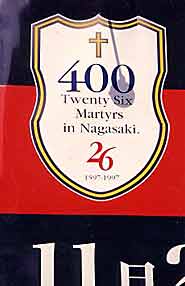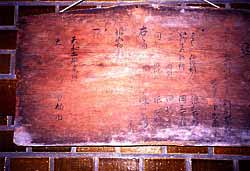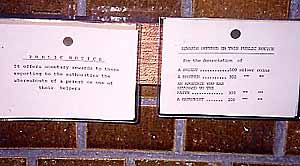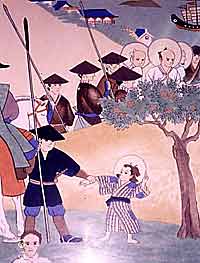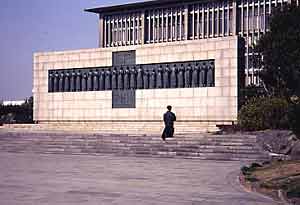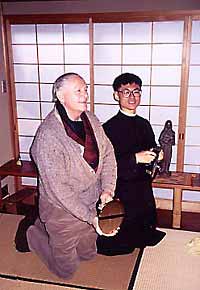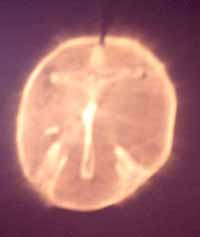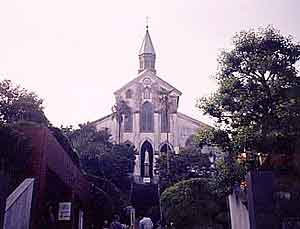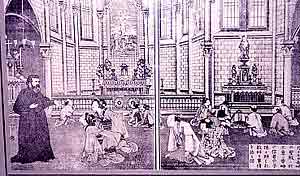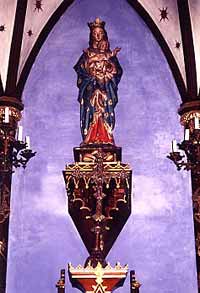

![]()
![]()
|
Newsletter of the District of Asia November - December 2000 History of the Japanese Missions1) The "Christian Era" (1549-1638) Two great periods divide that era: from the arrival of St. Francis of Xavier on August 15, 1549 to the edict of general persecution of 1614, and then from 1614 to the definitive "closure" of Japan in 1638.
At the beginning, the Jesuits are alone but in 1592, the arrival of missionaries from other religious orders coming from the Philippines make them share the administration of the Mission. St. Francis Xavier spent just about 2 years in the Japanese soil, making numerous openings for divine grace. When he left in November 1551, a little thousand faithful had received the gift of faith, at their head was his Spanish companion, Fr. Cosme de Torres, helped by a brother fluent in Japanese. The minute nucleus of Christians, in the South of Kyushu did not grow due to the hostility of the daimyo. In the North of the island, in Bungo, Xavier had indeed got permission to preach and baptize freely, however, he doesn’t seem to have made any neophytes, by lack of interpreter. It is in Yamaguchi on the other side of the strait on the greater island that the apostolate of Fr. Torres and his brother gave some fruits. All seemed to collapse though during the civil wars. But the situation eventually settled itself. The golden age of Japanese Christianity, the period of quick conquests and unlimited hopes, expands from 1551 when Xavier left until 1587. The Southern churches, Yamaguchi, Bungo, Hizen very soon reached a high degree of prosperity. In 1563, the first daimyo is baptized. He would be followed by many others, some very influential in the following years. During that time, further North, in Kyoto, where Fr. Vilela had settled in 1559, as well as in the central provinces, the success is not less spectacular. Bonzes, samurai, daimyo, even Kuge are converted. If political troubles interrupted the propaganda between 1564 and 1568, it continued afterwards with Oda Nobunaga in power who openly took the Christians under his wings. In 1577 the fathers erected in Kyoto the splendid church of the Assumption. Nobunaga allowed another church with a school for young noble men in Azuchi, on the shore of lake Biwa. After the death of Nobunaga and the fire of Azuchi (1582), the Jesuits settled in Osaka, near the master of Japan Toyotomi Hideyoshi and found the same favor with him. There too, famous conversions took place especially that of Konishi Yukinaga, the grand Admiral of Hideyoshi and that of Kuroda Yoshitaka, the general of his cavalry. What were the causes of these achievements? There were many Catholic Missionaries arrived at the right moment, they profited of the confusion of souls, of the decadence of Buddhism and of the contempt in which its leaders was kept. In contrast, the missionaries edify by their disinterestedness, their morals, by the absolute conformity between their life and their teaching. People ran to them first out of burning curiosity but this soon changed into real enthusiasm for these strangers who preached the contempt of riches, and didn’t care to acquire any, who preached humility and answered to insults with kindness, who preached abstinence and did not get drunk, who preached purity and did not live with women. As they practiced celibacy and organized occasionally pompous ceremonies, they did not shock the traditional concept Japanese had of the priest and of worship. Moreover, members of the same Order, united not only by the same faith but by the same discipline, guided by the example and advice left by St. Francis Xavier, they tried to adapt to the native customs whenever possible and were extremely prudent never to hurt the susceptibilities, so easily enflamed of this people proud and jealous of its independence. Christianity also found in the political state of the country favorable circumstances for its free development. The central power of the Mikado being only a shadow, the daimyo, local feudal lords, as the absolute master of his domains. Thus, Christian propaganda did not risk a conflict with a higher power. The daimyo could accept or prescribe in all freedom the Christian religion with no one to contradict them. Moreover, by embracing this religion, they gave themselves greater independence. Through the missionaries, they could enter in relation with the heads of foreign states, they could send and receive embassies. That also explains why Christianity obtained then so much success among the territorial nobility of which the example had obviously a strong influence on the samurai of every rank and on the people. Thus, the conversion of daimyo were the most characteristic trait of the history of Japanese Christianity. While in Central Japan, the number of Christians did not grow very much between 1570-1579, there were massive conversions in the Kyushu. In the state of Omura, the daimyo Sumitada baptised in 1563 had only 5,600 Christian subjects. In 1571, threatened by a local rebellion, he launched against the bonzes; in 1575, there were no more non-Christians in his possessions.
The persecution becomes official. The 'wanted sign' in Japanese. Through frequent and moving alternatives of success and failure, the regions of the Kyushu seedbed of the new religion, finally saw another strong movement of conversions crowned by the baptism of St. Francis Xavier’s old friend Otomo of Bungo (28 Aug. 1578).
Translation
of the sign:
Few events in Church history have struck so vividly the imagination of Christians all over the world as the glorious death of the Twenty-Six Martyrs of Japan in the year 1597; and few places in the Far East appeal so strongly to the religious feelings of Christians as the Holy Mountain in Nagasaki where these martyrs sealed in blood their faith in Jesus Christ by dying on the cross in imitation of Christ Himself.
The
arrest took place in Kyoto, Among them were priests, brothers and laymen, Franciscans, Jesuits and members of the Third Order of St. Francis; there were catechists, altar boys, doctors, simple artisans and servants: old men and innocent children; all united in a common unshakable faith and a burning love for Jesus and His Church. Thanking God for the grace of martyrdom they departed this earthly life singing from their crosses the Te Deum, and the children went to heaven with the words of the psalm on their lips: "Praise the Lord ye children, praise ye the name of the Lord" (Ps. CXII).
Site of the execution of the 26 Martyrs of Nagasaki (Feb. 5, 1597) The memory of this event was never forgotten even in the darkest hour of persecution. In secret the Christians came to the Holy Mountain to implore the martyrs to obtain from God fidelity for themselves and the conversion of their fellowmen. (From Histoire Universelle des Missions Catholiques, Paris, 1956, vol. 1, pp. 286-314)
During
the persecution, the faithful had to hide all their sacramentals.
...
this! The artist has carved inside the 'mirror' a relief of Calvary.
Thus
the faithful were always reminded of Calvary, 2) Survival and Revival (1638 – 1865) For two hundred years, 1638-1854, Japan remained closed to all foreign influence. A few missionaries did try to re-enter but were rapidly arrested and executed. Finally, when Japan re-opened its doors for economic reasons in the mid-1850’s missionaries did not miss the occasion.
Fr.
Petitjean, from the Mission Etrangeres de Paris, in Oura, A first church was erected in Nagasaki and was blessed on February 19, 1865. Less than a month later, Friday, March 17, Feast of St. Patrick, after having celebrated Holy Mass, Fr. Petitjean of the Foreign Missions of Paris, met a group of Japanese women at the door of his church. Here is the account of this historical meeting from Fr Petitjean’s own pen:
Fr.
Petitjean's church in Oura was blessed on December 28, 1864.
:
...Japanese Catholics, in hiding for 200 years, On March 17, 1865, towards 12.30 pm, about 15 people were standing at the door of the church. Certainly moved by my Guardian Angel, I went near them and opened the door. I had barely had time to recite an our father when three ladies, in their fifties knelt beside me and said, their hand on their chest and at a low voice: “The heart of all of us here is no different than yours. “Really? But where are you from? They mentioned their village and added: “At home, almost everyone is like us! Blessed are You, O my God! for all the immense joy that then filled my heart. What a reward for five years of sterile labor! As soon as our dear Japanese opened up to me, they manifested a confidence in such a contrast with the manners of their pagan brothers. I had to answer to all their questions, speak to them about O Deous sama, O Yaso sama, santa Maria sama, the names they used for God, for Our Lord Jesus Christ, for Our Blessed Lady. When they saw the statue of Our Lady with the Child Jesus reminded them of the feast of Christmas which they had celebrated, they said, in the eleventh month. They asked me if we were at the 17th day of the month of sorrows (Lent). St Joseph is no stranger to them; they call him ‘the foster father of Our Lord –O Yaso samano yo fou.’ All of a sudden, in the middle of these multiple crossed-fired questions, sounds of footsteps are heard.` Everyone disappeared immediately. But as soon as the new comers had been identified, everyone was back laughing off their fright. “They come from the same village! They have the same heart as ours.” Nevertheless, soon after they had to leave in separate direction not to alert the attention of the Japanese officers whose visit I feared. “On May 15, the delegates of an island at a little distance from here came to see me. After a short conversation, we sent them away keeping with us the sole catechist and the leader of the devout caravan. The catechist, named Pierre, gave us the most interesting information. Let us say first that the formula for baptism is identical to ours and he pronounces it very distinctively. There are still, he says, many Christians all over Japan. He gave one place in particular where there were still 1000 Christian families. Then he questioned us on the great Leader of the kingdom of Rome, leader of which he wanted to know the name. When we told him that the august Vicar of Jesus Christ, the Sovereign Pontiff Pius IX would be very happy to hear the consoling news that we had just heard, Pierre manifested all his joy.
Fr.
Petitjean's original statue of Our Blessed Lady in Oura church, Nevertheless, before leaving us he wanted to be sure that we were truly the successors of missionaries of old. “Don’t you have any children? he asked us timidly. “You and your Japanese brothers, both Christian and pagans, these are the children the Good Lord has given us. But we cannot have any other children, because as priests, we must, as the first Apostles, remain celibate. Hearing this, Pierre and his companion bowed down all the way to the ground exclaiming: ‘They are virgins! Thank you! Thank you!” The next day, a whole Christian village asked for the visit of the missionaries, and two days later, 600 other Catholics sent a delegation of 20 people to Nagasaki. On June 8, 25 Christian villages had been identified by the missionaries and 7 ‘baptizers’ were put directly in touch with them. Thus, deprived of all exterior help, without any sacraments except baptism; by the grace of God, first of all, and thanks to the faithful transmission, in the families, of the teaching and of the examples of the Christians and Martyrs of the 16th and 17th centuries, the sacred fire of the true faith- or a least a burning spark of it – had been maintained in a country ruled by government tremendously hostile to the Christian religion. The only thing that now remained was to blow on this spark to rekindle the flame. From Les Missions Catholiques Françaises au XIXe siècle, by Fr. J.B. Piolet, SJ, (no publishing date but around 1900), vol.III, pp.440-445 |
||||||||||
